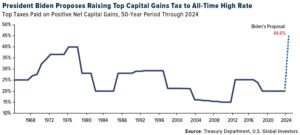Key takeaways
Interest rates matter
This is a hyper rate-sensitive environment given the aggressive tightening by many Western central banks.
Policymakers on guard
I’m optimistic that policymakers will remain vigilant in 2024 and quickly react to any issues that arise from their past tightening.
Cash off the sidelines
I believe the “fear of missing out” will accelerate in early 2024, leading cash-heavy investors to move into stocks and bonds.
Happy New Year! It’s January, which means it’s time to offer predictions for what the new year may bring for global markets in 2024. But first, it’s important to reflect on what we learned over the previous year — and there was no shortage of lessons learned about markets, the economy, and central banks. So I’ll start by reviewing my five key takeaways from 2023, and then offer five things I expect to see in the year ahead.
2023: Five lessons learned
- Policymakers around the world are very sensitive to the potential that something could “break” as a result of the aggressive rate hikes we have experienced. They were proactive in addressing possible accidents, as we saw during the mini regional banking crisis in March 2023, and also the UK gilt crisis in September 2022. That should provide some comfort to investors going forward. I’m optimistic that policymakers will remain vigilant and quickly react to any issues that arise from the aggressive tightening that many central banks have engaged in, recognizing the long and variable lags of monetary policy.
- Don’t believe what the Federal Reserve (Fed) tells you it’s going to do — believe what the data tells you the Fed is going to do. As I’ve discussed in recent months, many central bankers have maintained a hawkish public face even as substantial progress on disinflation continues. And so while the most recent “dot plot” indicates the Fed expects to cut rates by 75 basis points in 2024,1 I believe the Fed will likely cut between 100 and 150 basis points (of course depending on the data).
- Monetary policy has had an outsized impact on markets. Rates mattered a lot last year. This is a hyper rate-sensitive environment given the intense tightening cycle many Western developed economies have experienced. A drop in long rates in the last months of 2023 has had a powerful impact on many different asset classes, from equities to fixed income to gold.
- Don’t underestimate the power of psychology in impacting an economy. I expected a strong rebound for the Chinese economy last year given its post-pandemic re-opening, but I didn’t factor in the possibility that business and consumer sentiment would be tepid because of concerns about adequate stimulus. However, that also suggests that sentiment could quickly improve if businesses and consumers become more satisfied with policy going forward, and I expect that will be the case.
- Diversification remains critical, in my view. Consider what we saw last year within some of the major asset classes:
o Stocks. Chinese stocks disappointed due to the economic concerns I mentioned above, but overall, global equities gained more than 20% last year.2
o Bonds. Global bonds experienced gains for the year, with European and US high yield bonds as the standouts.3
o Commodities. Commodities posted losses, but gold was a juggernaut last year with demand helped by geopolitical risk buying, central bank purchases, and falling rates later in the year.4
In summary, and quite obviously, 2023 was a good year for markets — a balm for the wounds created by the annus horribilis that was 2022. If 2022 was captured in a country music song title, I believe it would be “How Can I Miss You If You Won’t Go Away?” But I definitely don’t feel the same way about this past year. If 2023 were captured in a country song title, I think it would be “If You Leave Me, Can I Come Too?”
In other words, 2023 was a good year, and I don’t think most of us would be eager to start 2024 if we thought the investing environment would change.
Fed in focus as 2024 begins
Now the first days of 2024 have unfortunately been more challenging. That is a reflection of anxiety and confusion around how much the Fed will cut rates this year. This has been fueled by some hawkish “Fedspeak” as well as some recent data.
But as Dallas Fed President Lorie Logan explained in a recent speech, “Restrictive financial conditions have played an important role in bringing demand into line with supply and keeping inflation expectations well-anchored. We can’t count on sustaining price stability if we don’t maintain sufficiently restrictive financial conditions.”5 This helps to explain why we have been hearing hawkish talk.
While I think some concern and volatility will persist, I believe data over the next several months will provide greater clarity that the Fed will cut rates significantly this year, which should be supportive of equities and fixed income. In other words, I think the first half of 2024 will largely be a continuation of the last few months of 2023 albeit with more volatility.
2024: Five predictions
- I expect at least one election to have a surprise outcome. But as we’ve seen before, elections don’t matter for markets in the longer run, so I don’t believe it’s worth worrying about. (Read my colleague Brian Levitt’s analysis of US presidential elections and stock market performance.)
- I expect more hawkish Fed speak early in the year. This is how the Fed keeps a lid on easing financial conditions (see the quote from Laurie Logan above). However, it can send yields higher and stocks and other assets lower, so we need to recognize the potential for greater market turbulence.
- I expect market breadth will continue to expand. In other words, I believe market performance will no longer be driven by just a small handful of stocks, as it was during 2023. I’m most excited about small-cap equities, as well as emerging markets equities and emerging markets bonds.
- I believe the “fear of missing out” on market performance will accelerate in early 2024, leading cash-heavy investors to move into stocks and fixed income strategies. I expect diversification to increase as investors rebalance and increase exposure to underexposed areas.
- The back half of the year is likely to be more tempered for equities; we could see some “give back” of gains from earlier in the year as markets worry about and discount 2025.
Dates to watch
| Date | Report | What it tells us |
| Jan. 8 | Eurozone consumer inflation expectations | Measures consumers’ expectations of future inflation. |
| Eurozone retail sales | Measures consumer demand. | |
| Eurozone unemployment | Indicates the health of the job market. | |
| US consumer inflation expectations (NY Fed) | Measures consumers’ expectations of future inflation. | |
| US consumer credit | Reports outstanding credit extended to individuals. | |
| Jan. 9 | Japan Consumer Price Index | Tracks the path of inflation. |
| German industrial production | Indicates the economic health of the industrial sector. | |
| Jan. 10 | China outstanding loan growth | Measures loans extended to consumers and businesses. |
| Jan. 11 | US Consumer Price Index | Tracks the path of inflation. |
| China Consumer Price Index | Tracks the path of inflation. | |
| Jan 12 | UK gross domestic product | Measures a region’s economic activity. |
| UK industrial production | Indicates the economic health of the industrial sector. | |
| US Producer Price Index | Measures the change in prices paid to producers of goods and services. |
Footnotes
- Source: US Federal Reserve, as of Dec. 13, 2023
- Source: Bloomberg, as of Dec. 29, 2023, as measured by the MSCI ACWI price index. The MSCI All Country World Index is an unmanaged index considered representative of large- and mid-cap stocks across developed and emerging markets. Price indexes do not take into account dividends and cash payouts.
- Source: Bloomberg, as of Dec. 29, 2023. European and US high yield bonds measured by the ICE Bank of America Euro High Yield Index and US High Yield Index. The ICE Bank of America Euro High Yield Index tracks the performance of euro-denominated, below investment grade corporate debt publicly issued in the euro domestic or eurobond markets. The US High Yield Index tracks the performance of US-dollar-denominated, below investment grade corporate debt publicly issued in the US domestic market. Global bonds measured by the ICE All Maturity Global Broad Market Index, which tracks the performance of US-dollar-denominated, below investment grade corporate debt publicly issued in the US domestic market.
- Source: Bloomberg, as of Dec. 29, 2023. Commodities measured by the S&P GSCI Index. The S&P GSCI Index is an unmanaged world production-weighted index composed of the principal physical commodities that are the subject of active, liquid futures markets. Gold spot prices based on Bloomberg aggregated data.
- Source: Federal Reserve Bank of Dallas, Jan. 6, 2024
—
Originally Posted January 8, 2024
Five market lessons from 2023, and five predictions for 2024 by Invesco US
Important information
NA3313772
All investing involves risk, including the risk of loss.
Past performance does not guarantee future results.
Investments cannot be made directly in an index.
This does not constitute a recommendation of any investment strategy or product for a particular investor. Investors should consult a financial professional before making any investment decisions.
Should this contain any forward looking statements, understand they are not guarantees of future results. They involve risks, uncertainties, and assumptions. There can be no assurance that actual results will not differ materially from expectations.
Diversification does not guarantee a profit or eliminate the risk of loss.
In general, stock values fluctuate, sometimes widely, in response to activities specific to the company as well as general market, economic and political conditions.
Stocks of small and mid-sized companies tend to be more vulnerable to adverse developments, may be more volatile, and may be illiquid or restricted as to resale.
Fixed-income investments are subject to credit risk of the issuer and the effects of changing interest rates. Interest rate risk refers to the risk that bond prices generally fall as interest rates rise and vice versa. An issuer may be unable to meet interest and/or principal payments, thereby causing its instruments to decrease in value and lowering the issuer’s credit rating.
Commodities may subject an investor to greater volatility than traditional securities such as stocks and bonds and can fluctuate significantly based on weather, political, tax, and other regulatory and market developments.
Fluctuations in the price of gold and precious metals may affect the profitability of companies in the gold and precious metals sector. Changes in the political or economic conditions of countries where companies in the gold and precious metals sector are located may have a direct effect on the price of gold and precious metals.
The risks of investing in securities of foreign issuers, including emerging market issuers, can include fluctuations in foreign currencies, political and economic instability, and foreign taxation issues.
Investments in companies located or operating in Greater China are subject to the following risks: nationalization, expropriation, or confiscation of property, difficulty in obtaining and/or enforcing judgments, alteration or discontinuation of economic reforms, military conflicts, and China’s dependency on the economies of other Asian countries, many of which are developing countries
The Federal Reserve’s “dot plot” is a chart that the central bank uses to illustrate its outlook for the path of interest rates.
UK gilts are bonds issued by the British government.
A basis point is one hundredth of a percentage point.
Disinflation, a slowing in the rate of price inflation, describes instances when the inflation rate has reduced marginally over the short term.
Fedspeak is a technique for managing investors’ expectations by making deliberately unclear statements regarding monetary policy to prevent markets from anticipating, and thus partially negating, its effects.
Inflation is the rate at which the general price level for goods and services is increasing.
Hawkish is to favor relatively higher interest rates if they are needed to keep inflation in check.
Yield is the income return on an investment.
A high yield bond is a bond that is rated below investment grade at the time of purchase.
Tightening monetary policy includes actions by a central bank to curb inflation.
Risk assets are generally described as any financial security or instrument that carries risk and is likely to fluctuate in price.
The MSCI All Country World Index is an unmanaged index considered representative of large- and mid-cap stocks across developed and emerging markets. Price indexes do not take into account dividends and cash payouts.
The ICE Bank of America Euro High Yield Index tracks the performance of euro-denominated, below investment grade corporate debt publicly issued in the euro domestic or eurobond markets. ICE All Maturity Global Broad Market Index tracks tracks the performance of US-dollar-denominated, below investment grade corporate debt publicly issued in the US domestic market.
The S&P GSCI Index is an unmanaged world production-weighted index composed of the principal physical commodities that are the subject of active, liquid futures markets.
The opinions referenced above are those of the author as of Jan. 8, 2024. These comments should not be construed as recommendations, but as an illustration of broader themes.
Disclosure: Invesco US
This does not constitute a recommendation of any investment strategy or product for a particular investor. Investors should consult a financial advisor/financial consultant before making any investment decisions. Invesco does not provide tax advice. The tax information contained herein is general and is not exhaustive by nature. Federal and state tax laws are complex and constantly changing. Investors should always consult their own legal or tax professional for information concerning their individual situation. The opinions expressed are those of the authors, are based on current market conditions and are subject to change without notice. These opinions may differ from those of other Invesco investment professionals.
NOT FDIC INSURED
MAY LOSE VALUE
NO BANK GUARANTEE
All data provided by Invesco unless otherwise noted.
Invesco Distributors, Inc. is the US distributor for Invesco Ltd.’s Retail Products and Collective Trust Funds. Institutional Separate Accounts and Separately Managed Accounts are offered by affiliated investment advisers, which provide investment advisory services and do not sell securities. These firms, like Invesco Distributors, Inc., are indirect, wholly owned subsidiaries of Invesco Ltd.
©2024 Invesco Ltd. All rights reserved.
Disclosure: Interactive Brokers
Information posted on IBKR Campus that is provided by third-parties does NOT constitute a recommendation that you should contract for the services of that third party. Third-party participants who contribute to IBKR Campus are independent of Interactive Brokers and Interactive Brokers does not make any representations or warranties concerning the services offered, their past or future performance, or the accuracy of the information provided by the third party. Past performance is no guarantee of future results.
This material is from Invesco US and is being posted with its permission. The views expressed in this material are solely those of the author and/or Invesco US and Interactive Brokers is not endorsing or recommending any investment or trading discussed in the material. This material is not and should not be construed as an offer to buy or sell any security. It should not be construed as research or investment advice or a recommendation to buy, sell or hold any security or commodity. This material does not and is not intended to take into account the particular financial conditions, investment objectives or requirements of individual customers. Before acting on this material, you should consider whether it is suitable for your particular circumstances and, as necessary, seek professional advice.
































Join The Conversation
If you have a general question, it may already be covered in our FAQs. If you have an account-specific question or concern, please reach out to Client Services.